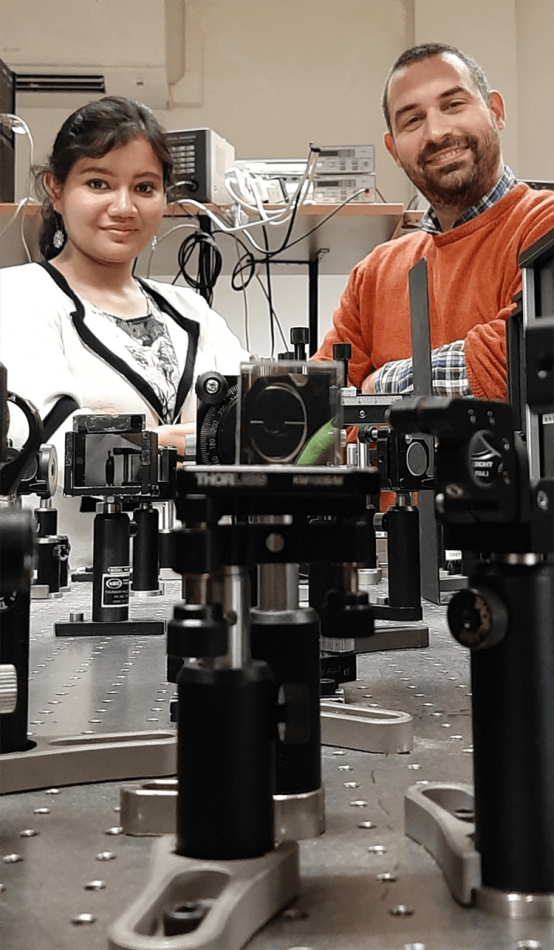Sep 16 2020
A group of scientists from Centre for Research on Adaptive Nanostructures and Nanodevices (CRANN) and the School of Physics at Trinity College Dublin, has found that a novel material can behave as a super-fast magnetic switch.
 Dr Karsten Rode, Senior Research Fellow in the “Magnetism and Spin Electronics Group” in Trinity’s School of Physics, suggests that the discovery just marks the beginning of an exciting new research direction. Image Credit: Centre for Research on Adaptive Nanostructures and Nanodevices (CRANN) and Trinity College Dublin.
Dr Karsten Rode, Senior Research Fellow in the “Magnetism and Spin Electronics Group” in Trinity’s School of Physics, suggests that the discovery just marks the beginning of an exciting new research direction. Image Credit: Centre for Research on Adaptive Nanostructures and Nanodevices (CRANN) and Trinity College Dublin.
When the material is hit by consecutive ultra-short laser pulses, it displays “toggle switching” that may boost the capacity of the global fiber optic cable network by an order of magnitude.
Expanding the Capacity of the Internet
Changing between two states—that is, 0 and 1—is the mainstay of the internet and the basis of digital technology. The high majority of all the data that is downloaded is preserved magnetically in large data centers throughout the world, connected by an optical fiber network.
Challenges to further proceed with the internet are three-fold, particularly the energy consumption and speed of the magnetic or semiconducting switches that process and store the data and also the capacity of the fiber-optic network to manage it.
The latest discovery of ultra-fast toggle switching utilizing laser light on mirror-like films of MRG—an alloy of manganese, ruthenium, and gallium—could help with all the three challenges.
Light provides an excellent benefit in terms of speed, while magnetic switches do not require power to retain their state. More significantly, they currently provide the possibility of fast time-domain multiplexing of the prevalent fiber network, which could allow it to manage 10 times as much data.
The Science Behind Magnetic Switching
Dr Chandrima Banerjee and Dr Jean Besbas, both working in the photonics lab at CRANN, Trinity’s nanoscience research center, utilized ultra-fast laser pulses that last only a 100 fs (that is, one ten thousand billionths of a second) to change the magnetization of thin films of MRG to and fro. The direction of magnetization can point either in or out of the thin film.
With each consecutive laser pulse, it suddenly flips its direction. Every pulse is believed to temporarily heat up the electrons in MRG by around 1000 °C, which causes to flip its magnetization. The finding of ultra-fast toggle switching of MRG was recently published in the renowned international journal, Nature Communications.
Dr Karsten Rode, Senior Research Fellow in the “Magnetism and Spin Electronics Group” in Trinity’s School of Physics, proposed that this latest discovery simply heralds the beginning of a new, exciting research direction.
We have a lot of work to do to fully understand the behaviour of the atoms and electrons in a solid that is far from equilibrium on a femtosecond timescale. In particular, how can magnetism change so quickly while obeying the fundamental law of physics that says that angular momentum must be conserved?
Dr Karsten Rode, Senior Research Fellow, School of Physics, Trinity College Dublin
Dr Rode continued, “In the spirit of our spintronics team, we will now gather data from new pulsed-laser experiments on MRG, and other materials, to better understand these dynamics and link the ultra-fast optical response with electronic transport. We plan experiments with ultra-fast electronic pulses to test the hypothesis that the origin of the toggle switching is purely thermal.”
In 2021, Chandrima will continue her study at the University of Haifa, Israel, with a team that is capable of creating even shorter laser pulses. The Trinity team, under the guidance of Dr Rode, has planned a new joint project with colleagues in Switzerland, Norway France, and the Netherlands, with an aim to prove the idea of ultra-fast, time-domain multiplexing of fiber-optic channels.
The study that made the recent discovery was funded by Science Foundation Ireland, the Irish Research Council, and the European Commission.
Journal Reference:
Banerjee, C., et al. (2020) Single pulse all-optical toggle switching of magnetization without gadolinium in the ferrimagnet Mn2RuxGa. Nature Communications. doi.org/10.1038/s41467-020-18340-9.